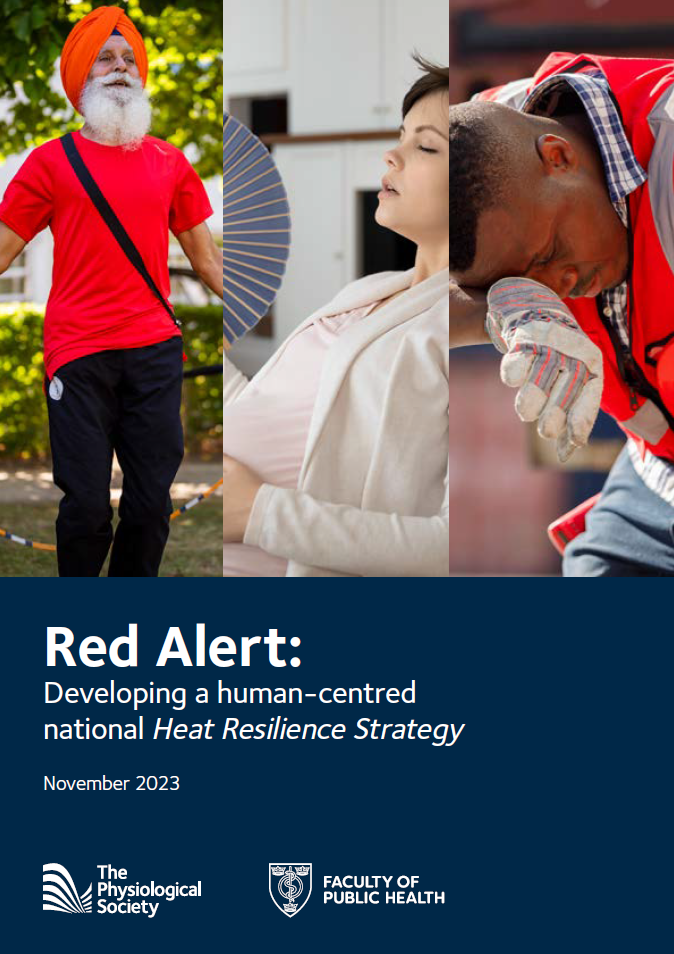Our new report
Our new report with the Faculty of Public Health Developing a Human-centred National Heat Resilience Strategy calls for the formation of a Heat Resilience Strategy that is focused on improving the understanding of how heat impacts vulnerable groups and improving the preparedness of the nation to deal with extreme temperatures. The report launched in the Houses of Parliament on 20 November 2023.
Watch our report launch video
Our Call for Action – a summary of our recommendations
We call for the UK Government and devolved administrations to urgently develop a National Heat Resilience Strategy that is rooted in physiology to protect vulnerable populations from the health impacts of extreme heat. The strategy must coordinate efforts of governments across the UK, local authorities, the NHS, research funders, and employers to improve population resilience in response to rising temperatures. View our recommendations for research, built environment, business and public health below:
Recommendations
Research
Recommendation
Establish a Heat Adaptation Research Exchange Taskforce, chaired by the Cabinet Office working closely with other government departments and devolved administrations. This Taskforce will tackle research gaps and increase the speed of research translation into policy and action. The taskforce should focus efforts on those deemed most vulnerable and where the most significant research gaps remain, including older people, pregnant women and people, people with pre-existing conditions, and those who take prescription medications.
What do we want to achieve?
Improved heat resilience by improving our knowledge base through a greater focus and funding on the research gaps identified in this report, particularity around vulnerable populations, and ensure communities can benefit from the research quickly.
Built environment
Recommendation:
Form a Human Centred Climate Adaption Design and Planning Institute to accelerate the adaptation of the built environment to higher temperatures, with governments across the UK mandating thermally efficient design principles and promoting the use of green infrastructure.
What do we want to achieve?
Buildings and urban spaces will be designed will be informed by the physiological response to increased heat and in such a way to support people to adapt to rising temperatures without requiring a huge increase in the reliance on air conditioning.
Business
Recommendation
Require employers to develop a physiologically-informed and sustainable plan for workers during extreme heat events to protect health, safety, wellbeing and productivity. The Health and Safety Executive should update occupational responses to extreme heat to take into account temperature, humidity, airflow and pollutions, work/rest scheduling, work equipment and clothing. This should include introducing statutory guidance on maximum temperatures for different levels of activity and types of Personal Protective Equipment worn.
What do we want to achieve?
This will protect workers across all sectors of the UK’s economy as temperatures increase.
Public Health
Recommendation
Improve early warning systems and bring together public health professionals from across UK and devolved governments, local authorities and charities to deliver a public health campaign focused on improving long-term resilience and preparedness for extreme heat amongst vulnerable groups.
What do we want to achieve?
Reduced health complications in vulnerable populations due to rising heat by ensuring they have the knowledge and capability to improve long term preparedness, as well as the information about when and how they should take action to keep safe.
Why do we Need a National Heat Resilience Strategy?
The UK is one of the most ‘dangerously unprepared’ countries for heat, if the international limit of 1.5°C of warming is broken, according to researchers at the University of Oxford.
Last year was the UK’s hottest year on record, and September 2023 has been the warmest September since 1884, according to the Met Office. The UK is also set to experience the greatest relative increase in uncomfortably hot days. Extreme heat can lead to dehydration, heat exhaustion, stroke and even death, especially in those most vulnerable to its consequences. During the extreme heat of summer 2022, there were an estimated 2,985 all-cause excess deaths.
In addition to the adverse health outcomes, heat also has economic consequences, due to the loss of productivity, crops, and infrastructure. The Lancet Countdown found that heat exposure led to the loss of over 11 million potential work hours in the UK in 2022.
Extreme heat disproportionately threatens the physical health of vulnerable populations such as young children, the elderly, pregnant people and those with pre-existing health conditions. Outdoor workers, people living in care homes and those with low socio-economic status will also be poorly impacted owing to a lack of agency or resource to adapt the conditions around them for human tolerance of heat.
At the same time, the UK is unprepared to deal with this extreme rise in temperature and currently lacks the ability adapt and prepare for its consequences. We need a multi-sectoral approach that encompasses the health service, farming, construction, housing, vulnerable populations and local requirements and puts people at the centre of its approach.


























